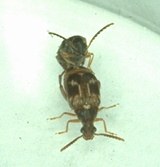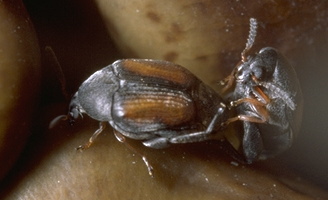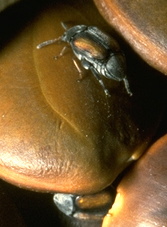

 My current position is as a postdoctoral associate in the laboratory of Dr. Charles Fox at the Universityof Kentucky. My research involves various aspects of life history evolution, behavioral ecology, and sexual selection in seed beetles. Several projects are currently in progress. Foremost among these is a combination of experimental and comparative work investigating the evolution of male body size and sexual dimorphism. In most insects, females are larger than males despite frequent evidence for sexual selection favoring male body size. Large female size is usually attributed to fecundity selection (larger females can lay more eggs over their lifetime). I investigated sexual selection and fecundity selection on male body size in two related species of seed beetle: in Callosobruchus maculatus (left) males are smaller than females, but in Stator limbatus (below-right) males are larger. My laboratory studies so far indicate that sexual selection favors large males in both species through male-male competition and sperm competition (females mating with large males are less likely to remate); if anything, the large male advantage was more pronounced for C. maculatus , in which males are smaller than females.
My current position is as a postdoctoral associate in the laboratory of Dr. Charles Fox at the Universityof Kentucky. My research involves various aspects of life history evolution, behavioral ecology, and sexual selection in seed beetles. Several projects are currently in progress. Foremost among these is a combination of experimental and comparative work investigating the evolution of male body size and sexual dimorphism. In most insects, females are larger than males despite frequent evidence for sexual selection favoring male body size. Large female size is usually attributed to fecundity selection (larger females can lay more eggs over their lifetime). I investigated sexual selection and fecundity selection on male body size in two related species of seed beetle: in Callosobruchus maculatus (left) males are smaller than females, but in Stator limbatus (below-right) males are larger. My laboratory studies so far indicate that sexual selection favors large males in both species through male-male competition and sperm competition (females mating with large males are less likely to remate); if anything, the large male advantage was more pronounced for C. maculatus , in which males are smaller than females. In neither species do females exhibit a clear preference for larger males,
although once mated, females are less likely to remate if they first mated with a large male. These species differ in another respect: in S. limbatus , variation in male size (which affects ejaculate size) contributes substantially to variation in female lifetime fecundity. This suggests that fecundity selection is also acting on males and may in part account for the relatively large size of males.
In neither species do females exhibit a clear preference for larger males,
although once mated, females are less likely to remate if they first mated with a large male. These species differ in another respect: in S. limbatus , variation in male size (which affects ejaculate size) contributes substantially to variation in female lifetime fecundity. This suggests that fecundity selection is also acting on males and may in part account for the relatively large size of males.
My finding that male size influences female reproductive success suggests that ejaculate size may be of considerable importance to both males and females. Therefore, I am investigating the importance of ejaculate size to female reproductive success and the factors that influence male ejaculate size in these species (most work is carried out with C. maculatus since this species is more tractable for these experiments). For example, I have investigated  the effect mating with a virgin versus a previously mated male (that has a smaller ejaculate) has on a female's lifetime fecundity, as well as her tendency to remate. Females mating to previously mated males have lower lifetime fecundity than females mating to virgins. A male's mated status also influences a female's tendency to remate: females mated to non-virgins remate more rapidly than females mated to virgins. This is at least in part due to the nutritional benefits provided by the male (rather than just a need for additional sperm) since females provided with additional nutrients (food) were less likely to remate. Given that male contributions are limiting (ejaculate size drops precipitously from one mating to the next), males are expected to be selective in who they fertilize and how much they contribute. My studies so far have detected no evidence of male mate choice, however.
the effect mating with a virgin versus a previously mated male (that has a smaller ejaculate) has on a female's lifetime fecundity, as well as her tendency to remate. Females mating to previously mated males have lower lifetime fecundity than females mating to virgins. A male's mated status also influences a female's tendency to remate: females mated to non-virgins remate more rapidly than females mated to virgins. This is at least in part due to the nutritional benefits provided by the male (rather than just a need for additional sperm) since females provided with additional nutrients (food) were less likely to remate. Given that male contributions are limiting (ejaculate size drops precipitously from one mating to the next), males are expected to be selective in who they fertilize and how much they contribute. My studies so far have detected no evidence of male mate choice, however.
I am also investigating the various factors that affect male ejaculate size. For example, I examined if there was genetic variation in ejaculate size (and hence the potential for it to evolve). The results from a half-sib experiment in one population suggest that at least some of the loci affecting this trait are located on the X-chromosome (although we can not completely exclude the possibility of a maternal effect). On the other hand, comparisons among populations demonstrate that among-population variation appears to be due to variation at autosomal loci. In addition to examining genetic variation in ejaculate size, I have also been investigating various environemnetal factors that may affect male nutritive contributions to females. Research carried out by a Eric Levine, a high school student in our lab, demonstrated that larval rearing density affects ejaculate size, but only insomuch as rearing density affects adult body size: males contribute a relatively fixed proportion of their body mass in their ejaculate. I am currently investigating if male ejaculate size is adjusted under different social situations (e.g. male or female-biased sex ratios). Preliminary studies suggest that males are not able to adjust ejaculate size in different circumstances.
Future projects being planned include: investigating the costs of multiple mating and of male harassment to females; testing if females are more likely to remate if presented with a novel male rather than the first male; and selection experiments on male ejaculate size and mating behavior.
Savalli, U.M. & Fox, C.W. 1998. Sexual selection and the fitness consequences of male body size in the seed beetle Stator limbatus . Animal Behaviour 55: 473-483..
We examined sexual selection on male body size in a laboratory population of the seed beetle, Stator limbatus , and the fitness consequences to females of mating with larger males. Large males produced larger ejaculates than small males. Both males and females lost body weight as a consequence of breeding, and large males lost more weight than small males. The amount of weight lost by males correlated as highly with female fecundity as did the amount of weight lost by females. Similarly, male and female body weight correlated equally highly with female fecundity. These results indicate that males make substantial contributions to female fecundity, most likely through nutrients transferred in their ejaculate. As a consequence, fecundity selection should favour large body size in both males and females.
We found no preference for large males when virgin females were presented with only one male but when presented with two males simultaneously, females were more likely to mate with the larger male. This result is consistent with relative female choice or male-male competition, although no overt indications of male-male competition were observed. Females that were mated to small males re-mated sooner than females that were first mated to large males. Females that were first mated to a non-virgin male were also more likely to r-emate than females that were first mated to a virgin male, suggesting that females re-mate to obtain additional sperm or nutrients and not just as a form of mate choice. In addition to the possible benefits from mate choice and male-male competition, large males gain a mating advantage through reduced sperm competition. This large male advantage, combined with fecundity selection on males as well as females, may account for males being larger than females in this species.
Savalli, U.M. & Fox, C.W. 1998. Genetic Variation in Paternal Investment in a Seed Beetle. Animal Behaviour 56: 953-961.
Males of many species invest resources in their offspring. For paternal investment to evolve, it must exhibit heritable variation. Using a standard half-sib quantitative genetic design, we investigated whether genetic variation in male ejaculate size, a trait that affects female fecundity, and copulation duration are present in the seed beetle Callosobruchus maculatus. Ejaculate size was estimated as the amount of weight lost by males during mating. Dams, but not sires, had significant effects on their sons' absolute ejaculate size (both replicates) and relative ejaculate size (proportion of body weight; one replicate only), explaining 21-25% of the variance in absolute ejaculate size and 8-16 % of the variance in relative ejaculate size. These results suggest either a large maternal effect on ejaculate size or sex linkage of loci that affect the variation in ejaculate size. The proportion of phenotypic variance explained by sex linkage (assuming no maternal effects) was 42 and 49% (ejaculate size) and 17 and 31% (relative ejaculate size) in the two replicates. These results indicate that male paternal investment can respond to selection, and that it may be able to do so especially rapidly because sex-linked traits have the potential to evolve much more quickly than autosomal traits. There were only weak negative correlations between ejaculate size and mating duration, contrary to what we predicted. There was additive genetic variation in female copulation duration, but not in male copulation duration, suggesting that copulation duration is under female control.
Savalli, U.M., & Fox, C.W. 1999. The effect of male size, age, and mating behavior on sexual selection in the seed beetle Callosobruchus maculatus. Ethology, Ecology and Evolution 11: 49-60.
We use laboratory mating experiments to examine the effect of male size, age, and mating behavior on fecundity selection and sexual selection in the seed beetle, Callosobruchus maculatus (Coleoptera: Bruchidae), a species in which females are larger than males. Female C. maculatus gain a fitness advantage, in the form of increased lifetime
fecundity, from mating with large males (which contribute larger ejaculates), but the partial correlation between male size and fecundity is weaker than the partial correlation between female size and her fecundity. Large males had a mating advantage relative to small males, both when a single male was presented to a female and when two males were present. However, this did not appear to be due to females rejecting male courtship attempts, but instead may be due to male-male competition. When females were mated to two males sequentially, neither the size of the first male nor the size of the second male influenced whether or how quickly a female remated. None of the other potential bases for sexual selection&emdash;male age, male mating experience, and male courtship persistence&emdash;appeared to influence male mating success. We discuss how patterns of sexual selection on body size and sexual size dimorphism in C. maculatus differ from patterns of sexual selection and dimorphism in another seed beetle, S. limbatus.
Savalli, U.M., & Fox, C.W. 1999. The effect of male mating history on paternal investment, fecundity, and female remating in the seed beetle Callosobruchus maculatus. Functional Ecology 13: 169-177.
In many organisms, males provide nutrients to females via ejaculates that can influence female fecundity, longevity and mating behaviour. We determined the effect of male mating history on male ejaculate size, female fecundity, female longevity and female remating behaviour in the seed beetle Callosobruchus maculatus. The quantity of ejaculate passed to females declined dramatically with successive matings. Despite the decline, a male's ability to fully fertilize a female did not appear to decline substantially until his fourth mating. When females multiply mated with males of a particular mated status, the pattern of egg production was cyclic, with egg production increasing after mating. Females multiply mated to virgins had higher fecundity than females mated to non-virgins, and females mated to twice-mated males had disproportionately increased egg production late in their life. Females that mated to multiple virgins, and consequently laid more eggs, experienced greater mortality than females mated only once or mated to non-virgins, suggesting that egg production is costly, and rather than ameliorating these costs, male ejaculates may increase them by allowing or stimulating females to lay more eggs. Females mating with non-virgin males remated more readily than did females mated to virgins. Females given food supplements were less likely to remate than females that were nutritionally stressed, suggesting that females remate in part to obtain additional nutrients.
Savalli, U.M., Czesak, M.E., & Fox,
C.W. 2000. Paternal investment in the seed beetle, Callosobruchus maculatus (Coleoptera: Bruchidae): Variation among populations. Annals of the Entomological Society of America 93: 1173-1178.
Ejaculate size in seed beetles (Coleoptera: Bruchidae) is subject to both sexual and fecundity selection. We examined interpopulation variation and inheritance of ejaculate size in the seed beetle Callosobruchus maculatus. There was significant variation among three populations in both body mass and the proportion of a male's body mass that was transferred to females during mating. The seed upon which beetles were raised had a small effect on male body size but not the size of their ejaculates. To investigate the inheritance of ejaculate size, we established inter- and intra-population crosses with two of these populations. The progeny of interpopulation crosses were intermediate between the intrapopulation (parental) crosses, suggesting additive genetic autosomal inheritance. This differs from an earlier study of a different population that suggested that ejaculate size was maternally inherited.
Charles Fox--Bruchid Evolutionary Biology
The Bruchid page at Royal Holloway
Timothy Mousseau--Evolutionary Biology of Crickets & Beetles
Paul Watson--Animal Behavior